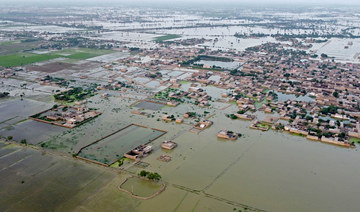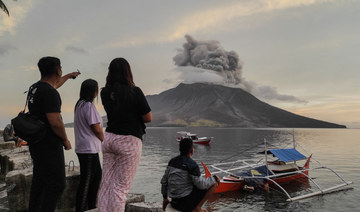BAGUIO CITY: China’s recent naming of five undersea features in the Benham Rise has prompted the Philippines to deploy troops to its northern frontier.
Benham Rise is a 13-million hectare underwater plateau, potentially rich in mineral and natural gas deposits, located near Aurora province in Northern Luzon.
In 2012, the UN confirmed that it is part of the Philippines. It was later renamed Philippine Rise by President Rodrigo Duterte.
On Friday, hundreds of Filipino Marines arrived at Port Irene in Cagayan from Mindanao. From dealing with extremists in the southern Philippines, their new task is to protect Philippine Rise from any foreign intrusion.
The deployment of troops comes one week after Duterte ordered the cessation of all marine exploration by foreign scientists and directed the Navy to “chase out” any vessel fishing or conducting research in Philippine Rise.
It is the first time that troops from Marine Battalion Landing Team 8 have been deployed in Northern Luzon. They will be integrated into Joint Task Force Tala under the 5th Infantry Division.
Lt. Gen. Emmanuel Salamat, Commander, Armed Forces of the Philippines Northern Luzon Command, told Arab News that this military deployment allows the Philippines to “promote and manifest our strong claims on the farthest islands of the northern frontier.”
Salamat stressed that it is not just troops he has at his disposal. “We are privileged to have additional platforms that include air and sea assets to be able to ensure regular maritime patrols in the Philippine Rise,” he said. “That is the marching order of the president: To secure our interests. We will continue to perform our mandated task, which is to protect our sovereignty.”
However, Salamat said that Marines would not be sent to secure Scarborough Shoal — an island group that was seized by China in 2012 that has long been a source of tension between the two countries. “That is a diplomatic issue,” Salamat said.
Duterte’s administration attracted heavy criticism when it was revealed that it had granted a request from China to explore the resource-rich waters of Benham Rise. But Duterte last week was unequivocal in his insistence that the Philippines had sovereignty over the region.
“Benham Rise belongs to the Filipino. We will claim exclusive ownership of the economic zones — 200 nautical miles,” he said.
“Let me be very clear about this: The Philippine Rise is ours and any insinuation that it is open to everybody should end with this declaration.”
Presidential spokesperson Harry Roque said in a statement on Thursday: “We object and do not recognize the Chinese names given to some undersea features in the Philippine Rise.”
He added that the Philippine Embassy in Beijing had already raised Manila’s concerns with China.
Tension mounts between Philippines, China over Benham Rise
Tension mounts between Philippines, China over Benham Rise

20 drown in boat accident in eastern Afghanistan, official says

- At least five bodies had been recovered and efforts were underway to find the others
- Official says five people survived the accident, the cause of which was being investigated
KABUL: Twenty people, including children, drowned when a boat sank during a river crossing in Afghanistan’s eastern Nangarhar province on Saturday, a provincial official said.
“A boat with women and children on board sank on Saturday morning at 7 am (0230 GMT) in the river in the Basawul area of Momand Dara district” of eastern Nangarhar, said Quraishi Badloon, the head of the province’s information department, in a post on social media platform X.
He said five people survived the accident, the cause of which was being investigated.
The Nangarhar Information and Culture Department said the authorities had sent a medical team and ambulances to the area, in a message shared with media.
At least five bodies had been recovered and efforts were underway to find the others, provincial government officials said.
Residents in the area regularly cross the river using boats often in poor condition, as there is no nearby bridge, local media reported.
South African vote tallying enters final stages with ANC on 40%

- The ANC has won every previous national election since the historic 1994 vote that ended white minority rule
- But its support has slid as the South African economy stagnated, unemployment climbed and infrastructure crumbled
MIDRAND, South Africa: Vote tallying in this week’s South African parliamentary election entered the final stages on Saturday, with the governing African National Congress (ANC) set to fall well short of a majority for the first time in 30 years of democracy.
The ANC has won every previous national election since the historic 1994 vote that ended white minority rule, but over the last decade its support has slid as South Africans have watched the economy stagnate, unemployment climb and infrastructure crumble.
With results in from over 97 percent of the more than 23,000 polling stations in Wednesday’s vote, the ANC stood at 40.11 percent, a precipitous drop from the 57.50 percent it secured at the last national election in 2019.
The biggest opposition party, the Democratic Alliance, was at 21.72 percent, while uMkhonto we Sizwe (MK), a new party led by former president Jacob Zuma, had 14.83 percent of the vote.
MK’s strong performance, especially in Zuma’s home province of KwaZulu-Natal, is one of the main reasons behind the ANC’s dismal showing.
The ANC will now have to strike a coalition deal or another form of agreement with one or more smaller parties to govern, an unprecedented prospect in the post-apartheid era.
Investors in Africa’s most industrialized economy will hope the uncertain picture will quickly become clear.
Political parties’ share of the vote will determine the number of seats they get in the National Assembly, which then elects the next president.
That could still be the ANC’s leader, President Cyril Ramaphosa, as the former liberation movement will remain the biggest party. But Ramaphosa will be badly weakened and is likely to face calls to quit from opposition parties and critics in the deeply-divided ANC.
On Friday, however, a top ANC official backed him to stay on as party leader, and analysts say there is no obvious successor to replace him.
The election commission has pencilled in a results announcement for Sunday.
20 drown in boat accident in eastern Afghanistan: provincial official

KABUL: Twenty people, including children, drowned when a boat sank during a river crossing in Afghanistan’s eastern Nangarhar province on Saturday, a provincial official said.
“A boat with women and children on board sank on Saturday morning at 7 am (0230 GMT) in the river in the Basawul area of Momand Dara district” of eastern Nangarhar, said Quraishi Badloon, the head of the province’s information department, in a post on social media platform X.
He said five people survived the accident, the cause of which was being investigated.
The Nangarhar Information and Culture Department said the authorities had sent a medical team and ambulances to the area, in a message shared with media.
At least five bodies had been recovered and efforts were underway to find the others, provincial government officials said.
Residents in the area regularly cross the river using boats often in poor condition, as there is no nearby bridge, local media reported.
UN official: Better warning, planning cut disaster deaths despite worsening climate

- People are getting better warnings about tropical cyclones so now the chances of dying are about one-third of what they were 20 years ago
- India, where temperatures have been flirting with 50° Celsius, has reduced heat deaths with specific regional plans
As climate change makes disasters such as cyclones, floods and droughts more intense, more frequent and striking more places, fewer people are dying from those catastrophes globally because of better warning, planning and resilience, a top United Nations official said.
The world hasn’t really noticed how the type of storms that once killed tens or hundreds of thousands of people now only claim handfuls of lives, new United Nations Assistant Secretary-General Kamal Kishore, who heads the UN’s office for disaster risk reduction told The Associated Press. But he said much more needs to be done to keep these disasters from pushing people into abject poverty.
“Fewer people are dying of disasters and if you look at that as a proportion of total population, it’s even fewer,” Kishore said in his first interview since taking office in mid-May. “We often take for granted the progress that we’ve made.”
“Twenty years ago there was no tsunami early warning system except for one small part of the world. Now the whole world is covered by a tsunami warning system” after the 2004 tsunami that killed about 230,000 people in Indonesia, Sri Lanka, India and Thailand, Kishore said.
People are getting better warnings about tropical cyclones — also called hurricanes and typhoons — so now the chances of dying in a tropical cyclone in a place like the Philippines are about one-third of what they were 20 years ago, Kishore said.
As the former disaster chief for India, Kishore points to how his country has cut deaths thanks to better warnings and community preparedness such as hospitals being ready for a surge in births during a cyclone. In 1999, a supercyclone hit eastern India, killing almost 10,000 people. Then a nearly similar sized storm hit in 2013, but killed only a few dozen people. Last year, on Kishore’s watch, Cyclone Biparjoy killed fewer than 10 people.
The same goes for flood deaths, Kishore said.
The data backs up Kishore, said disaster epidemiologist Debarati Guha-Sapir of the Catholic University of Louvain in Brussels, who created a global disaster database. Her database — which she acknowledges has missing pieces — shows that global deaths per storm event has dropped from about a ten-year average of 24 in 2008 to ten-year average of about 8 in 2021. Flood deaths per event have gone from ten-year averages of nearly 72 to about 31, her data indicates.
While there are fewer deaths globally from disasters, there are still pockets in the poorest of countries, especially in Africa, where deaths are worsening or at least staying the same, Guha-Sapir said. It’s much like public health’s efforts to eradicate measles, success in most places, but areas that can least cope are not improving, she said.
India and Bangladesh are poster nations for better dealing with disasters and preventing deaths, especially in cyclones, Guha-Sapir said. In 1970, a cyclone killed more than 300,000 people in Bangladesh in one of the 20th century’s greatest natural disasters and now “Bangladesh has done fantastic work in disaster risk reduction for years and years and years,” she said.
Pointing out wins is important, Guha-Sapir said: “Gloom and doom will never get us anywhere.”
While countries such as India and Bangladesh have created warning systems, strengthened buildings such as hospitals and know what to do to prepare for and then react to disasters, a lot of it is also just because these countries are getting richer and better educated and so they can handle disasters better and protect themselves, Guha-Sapir said. Poorer countries and people can’t.
“Fewer people are dying, but that’s not because climate change is not happening,” Kishore said ”That is despite the climate change. And that is because we have invested in resilience, invested in early warning systems.”
Kishore said climate change is making his job tougher, yet he said doesn’t feel like Sisyphus, the mythical man pushing a giant boulder up a hill.
“You are getting more intense hazards, more frequently and (in) new geographies,” Kishore said, saying places, like Brazil that used to not worry too much about floods now are getting devastated. The same goes for extreme heat, which he said used to be an issue for only certain countries, but now has gone global, pointing to nearly 60,000 heat wave deaths in Europe in 2022.
India, where temperatures have been flirting with 50° Celsius, has reduced heat deaths with specific regional plans, Kishore said.
“However with the new extreme temperatures we are seeing, every country needs to double its efforts to save lives,” he said. And that means looking at the built environment of cities, he added.
Cutting deaths is only part of the battle to reduce risk, Kishore said.
“We are doing a better job of saving lives but not of livelihoods,” Kishore said.
While fewer people are dying “you look at people who are losing their houses, people who are losing their businesses, a small farmer that is running a poultry farm,” Kishore said. When they get flooded or hit by a storm, they may survive but they’ve got nothing, no seeds, no fishing boats.
“On that we’re not doing as well as we should,” Kishore said. “We cannot accept that losses will occur. Of course they will occur, but they could be minimized by an order of magnitude.”
Indonesia’s Mount Ibu erupts as disaster agency warns of possible floods, cold lava flow

- Mount Ibu’s recent activity follows a series of eruptions of other volcanoes in Indonesia
- Archipelagic country sits on the Pacific ‘Ring of Fire’ and has 127 active volcanoes
JAKARTA: A volcano in Indonesia’s eastern island of Halmahera erupted on Saturday spewing a five-kilometer high ash cloud, the country’s volcanology agency (PVMBG) said, while its disaster agency warned of potential flash floods and cold lava flow.
The eruption of Mount Ibu at 11:03 a.m. (0203 GMT) follows a series of eruptions in May, after authorities noticed an uptick of volcanic activity starting in April, leading to the evacuation of seven nearby villages.
“The ash column is grey with thick intensity and leaning toward the southwest,” the agency said, adding that residents and tourists should maintain a distance of at least 7 km from the active crater.
Footage shared by the agency showed the volcano spewing ash that grew thicker and eventually dispersed.
Indonesia’s disaster management agency BNPB told local authorities to anticipate secondary disasters such as flash floods and cold lava flow. Analysis by the nation’s meteorology agency shows the region has the potential for moderate to heavy rain, although it did not say when.
“If there is a buildup of material left over from the eruption, it should be cleaned up immediately because it is dangerous. If there is heavy rain, flash floods could occur, cause damage and many fatalities,” Suharyanto, the BNPB chief, had said in a statement on Friday.
The volcano has been on PVMBG’s highest alert level since May 16. Mount Ibu’s recent activity follows a series of eruptions of other volcanoes in Indonesia, which sits on the Pacific “Ring of Fire” and has 127 active volcanoes.
Flash floods and cold lava flow from Mount Marapi, one of the most active volcanoes in West Sumatra province, covered several nearby districts following torrential rain on May 11, killing at least 67 people with 20 people still missing.

















